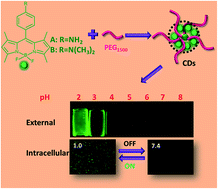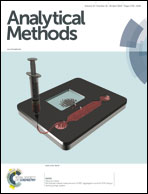BODIPY-based carbon dots as fluorescent nanoprobes for sensing and imaging of extreme acidity
Abstract
Two kinds of novel water-soluble carbon dots (CD-A and CD-B) were synthesized from 4-bora-3a,4a-diaza-s-indacene (BODIPY) derivatives, and their abilities for sensing pH under extremely acidic conditions were studied. The fluorescence of CD-A is linearly proportional to the extreme acidity range of 1.5–4.0 with a pKa of 2.90, while CD-B exhibits a linear response over the pH range of 1.0–4.0 with a pKa value of 2.63. In addition, both CD-A and CD-B were successfully applied to visualize extreme acidity in bacteria. The results demonstrate that CD-A and CD-B can serve as promising nanoprobes for the determination of extremely acidic pH values with excellent biological significance.



 Please wait while we load your content...
Please wait while we load your content...